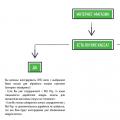Many PC users have old, used UPSs available. A common cause of disability is battery failure. Since replacing with new batteries is unprofitable, and sometimes simply impossible due to the lack of analogues, these devices are simply lying around idle or thrown into the trash.
But you can give a second life to the UPS by making a very useful device out of it - an inverter that converts 12 in the car's on-board network into 220 V, necessary for some devices. Moreover, the factory version of the inverter will cost a lot of money, but this way you will save money and make the necessary thing out of junk.
So, the first thing to do is remove the old, leaking batteries. They are quite simple to dismantle by removing the bottom cover and disconnecting the power wires. If there are traces of leaked electrolyte, clean the case from oxidation crystals.
Such an operation will ensure the elimination of further acid leakage, and also significantly lighten the weight of the apparatus.
Changing the connection diagram
In terms of design, uninterruptible power supplies are different, but the principle of operation is the same - to convert the voltage of 12 V to 220 V. That is, each model has a board with an electronic voltage converter. He is what we need. But there is one condition, it must be working.
Since the devices that will be connected to this device have a standard 220 V plug, it is necessary to install a regular household outlet for hidden wiring on the side or rear panel. To it we solder the output wires from the 220 V converter, which previously fit the special three-arm plugs on the rear panel of the UPS.
In the first and second case, the wires are soldered to those that went to the UPS battery. It is very important to observe the polarity of the connection. The red wire is a plus and the black wire is a minus.
As in the car network, and in the UPS, these colors must match. It is best, of course, to check the polarity with a multimeter to be sure.
This connection scheme provides for the instant operation of the device when it is connected. If you want to turn on through a toggle switch or an automatic machine, then simply break the "plus" in the wire coming from the car battery and connect one wire to the input, and the other to the output of the machine attached to the UPS case. This cuts off the power to the inverter when needed.
Subtleties in work
It should be understood that such a device will not deliver much power. Usually. it is no more than 150 W, but this is quite enough for connecting a small TV, laptop and other low-current equipment.
Why the car battery does not charge from the charger
The company "Metal +" offers its customers in Moscow to accept batteries from UPS, the price of which is higher than the average in the capital. We have a network of reception centers, trained by specialists, equipped with transport for the removal of batteries and favorable conditions for our customers.
Why is it profitable to hand over the battery from the UPS
Source batteries uninterruptible power supply(UPS) are considered one of the safest self-contained chemical energy sources and are used to protect professional equipment and household personal computers from strong drops electrical voltage online. Their durability is 3-5 years, depending on the intensity and operating conditions.
After the battery reaches its end of life, it becomes dangerous (lead acid "filling"), but it cannot be simply thrown into a landfill or stored at home. It is necessary to dispose of it, and the question arises before the owner, how to properly and quickly hand over the battery from the uninterruptible power supply?
Acceptance of UPS batteries is carried out by special companies that have the necessary permits, trained specialists and disposal experience. In the capital of the Russian Federation, the company "Metal +" is ready to offer you such a service, which:
- receives used batteries from an uninterruptible power supply on the basis of its receiving points;
- helps to quickly remove and dispose of batteries in accordance with the requirements of regulatory organizations;
- protect the environment and health of employees;
- avoid serious environmental penalties.
The purchase of batteries is beneficial for recycling companies that extract chemically pure non-ferrous metals from batteries (the cost price is 50% lower than new ones). Therefore, the prices for UPSs are quite high, and you have the opportunity to conveniently and without problems get rid of the dangerous battery, and also make money on it!

Battery Acceptance Conditions
If you are deciding where to return a battery from a UPS in Moscow, contact Metal +, whose specialists accept any UPS models on favorable terms. We offer two options for delivery:
- Pickup at the battery collection point in Moscow, where you can deliver the batteries yourself. The points work seven days a week, are equipped with accurate scales and containers for storing batteries, make payments to customers on the spot.
- Delivery by our specially equipped transport from anywhere in the capital and Moscow region. Transport is equipped with mobile scales.
Depends on:
- masses and capacities;
- type (polyethylene / polypropylene) and condition of the case;
- content of non-ferrous metals;
- the volume of the handed over metal (wholesale is always more expensive).
We accept batteries from uninterruptible power supplies at a price of 70 rubles / kg, which is higher than the average in the capital (you can study the prices in our price list on the website). We can also calculate the preliminary cost of scrap metal by phone call.
Our collection points offer:
- work seven days a week;
- accurate weighing of metal volume;
- fast recycling of batteries for UPS in a specialized workshop;
- correct disposal;
- settlement on site / to the customer's account.
When ordering the transport "Metal +" for the removal of UPS, you can count on the prepared trucks, accurate weighing, quick and complete calculation and removal without your participation.
The options for the removal of batteries and the form of calculation can be clarified with our managers when ordering the service.
Where to take in Moscow
Returning a battery to "Metal +" means:
- any advice on the purchase of scrap metal;
- a network of reception centers in all districts of Moscow;
- self-pickup / removal of scrap;
- any form of settlement on the spot;
- high prices and discounts for wholesale;
- contract for the provision of services for regular customers.
With this post, I begin a story about a series of upgrades that my Volga has undergone recently. Today we will talk about how to get a relatively powerful source of 220V electricity in a car, while, in fact, with zero investment.
Situations when it is required to have urban voltage in the car electrical network, occur quite often. For example, I have to occasionally transport live fish over long distances for work, and I need to connect oxygen compressors somewhere. Plus, for a long time there was an idea to organize a full-fledged navigator's place for long-distance runs, and this requires connecting a laptop. Then, in the long term, there are plans to assemble a refrigeration unit for transporting fish in the heat, the donor for which will be an old refrigerator powered by a 220V network. Well, on little things - often you don't even expect when and why you need apartment electricity in the car, so it's better to let it always be.
Of course, today you can buy various kinds of inverters, as they say, for every taste and wallet, but the devices that I had to deal with had two significant drawbacks. First of all, it is low maximum power. For example, the most common inverters, which are included in the lighting and do not require special installation on the car, have a maximum load of about 150W. Slightly more advanced modules, which already require a standard installation, still rarely reach the 300W mark, and they are more expensive. The second major drawback is the quality of the electrical sine wave that the inverter produces. It is clear that when converting from direct current to alternating current, the sinusoid is artificially modulated, but the quality of this modulation is different for different devices. In the same inverter connected to the cigarette lighter (which I had until now), the nature of the sinusoid is far from optimal, as a result, when the laptop was connected, its adapter got very hot, which, in theory, could lead to a breakdown of an expensive unit. It is possible, of course, that inverters of the highest price category and are devoid of the voiced shortcomings, but they have another, no less significant, minus - the price. Personally, I'm not ready to give the cost of a set of winter tires for an inverter.
The solution was found in using the board from an old uninterruptible power supply (hereinafter abbreviated as UPS). In general, I already wrote about how I successfully used a car battery for a UPS at home (), and now the opposite idea arose - to use a UPS in a car. Fortunately, I just had a broken UPS - it did not see the connection to the mains (i.e., it did not charge the battery and did not pass the mains current to the consumers), but it perfectly converted 12V DC to 220V AC, at the same time, it had peak power 800W. Exactly what is needed!
However, if you decide to follow in my footsteps and make a car inverter from a UPS, then do not forget to take into account one point - many modern uninterruptible power supplies have a shutdown timer, which is hardwired into the board. Such devices, through certain time work (say, after 15 minutes) is turned off, regardless of the battery charge level. They are not suitable for use as a car inverter. But I was lucky, I had a UPS that was not the first freshness, and when it was produced, it is likely that the shutdown timer has not yet gained popularity (I don’t remember the model exactly, but CyberPower).
And so, for a start, you should throw out the device case - it will not be needed, because it is planned to install a stationary outlet mounted in the car's interior. Getting into the car, you need to solve two main problems - where to get power and where to place the inverter. I'll tell you about the solution of these issues using the example of my "Volga".
To begin with, I began to solve the issue with power supply, even asked on a thematic forum, but opinions were divided there - some insisted on connecting such a load directly to the battery, while others allowed it to be connected to the steering column block. It is clear that it is more reliable to connect to the battery, but I really didn't want to drill a hole in the engine compartment. At the same time, the wire, in fact, directly from the battery, goes to the ignition lock, and this is convenient, but the disadvantage is that this wire has insufficient diameter to provide such power. In addition, I planned to put on the same line and heated seats.
But, in the end, I figured out all the options, and nevertheless decided to connect to the ignition switch, only providing the connection with a fuse not at 70A, as it should be for the load, but at 40A, that is, for the load for which the on-board network is designed " Volga ". This solution will slightly reduce the maximum allowable power of the inverter, but I do not have a task to use it by 100% (the load, at least according to the plans, should not exceed 400W, and then it will rarely be). In any case, I do not risk a fire in the car - the borate network is designed for 40A, and the fuse will not miss a large load.
Connection via a fuse under the steering block (in the photo, during the tests, a 20A fuse was used).
Now, when it became clear what to connect the inverter to, it remains to solve the second question - where to install it. The board there is quite impressive, it should stand not far from the control panel (because I didn't want to bother with lengthening two dozen small wires). At the same time, it was necessary to place the outlet on the side of the passenger-navigator's seat.
Then I remembered that on the Volga with the ZMZ-406 engine, to the right of the passenger's leg, behind the door, under the "pot-bellied" plastic cover, there is an ECU. But I have a car with a Chrysler engine, and its “brain” is under the hood, but that “pot-bellied” pad is still present. It would be logical to think that it is empty under it, and there is enough space for the location of the entire inverter unit. In short, I unscrewed this pad, and there really is emptiness - lucky!
Now I figured out how the inverter units would be located (and there are actually three of them - the socket, the control board and the conversion board), outlined this location, and began to melt the holes with a hot knife on the burner.

Plastic cover with a socket and a control unit installed on it.
True, the weather left much to be desired, pouring rain, so we had to pull the army OZK between the door and the roof, and turn on the burner already under such cover.

Here is such an impromptu shelter from the rain
After the socket and control board have taken their places, it remains to install the inverter board itself on the back of the plastic panel. But this is no longer particularly difficult.

Inverter assembly on the back of the panel.
Now it remains to connect to the power supply and put the plastic cover back in place. Plus used the one mentioned above, and took the minus from the body from the nearest reliable connection... I collected everything, checked it - it works!

View of the 220V outlet in the passenger seat
At the same time, the system, of course, is not always on (so as not to put a load on the on-board network when it is not necessary). I kept the standard UPS control system, with all the indication - it not only informs about the status of the inverter, but also allows you to turn it on and off as needed.

Control board and socket are visible at close range.
But just in case, sound signal I did not turn off the operation of the inverter - a quiet squeak once a minute or two (I don’t remember exactly) doesn’t really bother me, but the chances of accidentally leaving the device turned on and putting the battery down dramatically decreases.
Well, actually, that's all for this - now I always have a powerful and high-quality 220V AC source in my car. In the following post, we'll talk about how to modernize and improve the climate control unit on the Volga.
There is good use for old uninterruptible power supplies that are not in use due to a minor malfunction or because it is not cost effective to replace the battery. I have such a unit, produced in the mid-90s, with a long-term unusable battery. I will redo it.
These UPSs usually have sealed acid batteries that can be easily removed by removing 1 or 2 screws through the door at the bottom. In my case, it turned out that the battery had swollen, leaked, covering the compartment with white crystals of acid. Therefore, it was necessary to remove the case to remove and clean it.

Electrical modification
We assume that the electronics are in good working order, then the alteration is as follows:
1. Disconnect the network cable. Cut off the power plug and solder the 12V connector. While this cord will work, it is best to use another cord with a larger wire diameter. Low voltage and DC mean high amperage values, therefore thicker wires are needed.

2.
We insert a new cable into the regular hole and secure it with a stopper.
3.
Disconnect the wires from circuit breaker... Solder one wire of the new cable to the rear contact of the circuit breaker.
4.
We connect the battery wires to the new input. We connect one wire to the 2nd contact of the circuit breaker. The other is with the second wire of the new cable. POLARITY SHOULD BE OBSERVED! Usually on cars the red wires are “+” and the black ones are “-”.
5.
We modify the mechanical switch on the front panel so that the unit works immediately when the connector is connected (you can also use a two-position switch). They often have 3 positions. "Common" is usually in the middle, the value of the other 2 is determined by the tester when the switch is pressed. We connect a common test / network with a contact.
Testing
We check the performance, the correct voltage and frequency values.
To adjust them, these blocks usually have trimming resistors.

Carefully! There is a high voltage of 220V!
 Usage
Usage
Putting the body together. The new inverter can be used for laptop, etc. Do not connect appliances with motors to it. For the UPS, it is generally recommended to load no more than 75% of the output power. If you haven't used a thick enough wire and plug, I would recommend reducing this figure to 50-60%.
And I also want to note one point, if you decide to buy a new car, that is, an excellent car dealership in Moscow, where the prices will pleasantly surprise you. Hurry, promotions and loans, discounts and helpful staff will help you with your choice.




